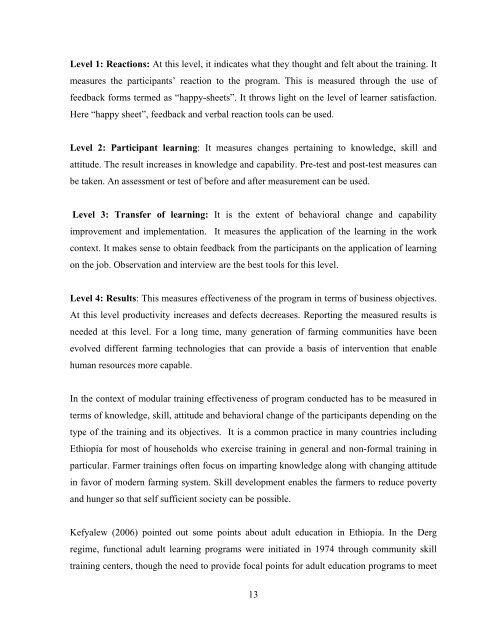effectiveness of modular training at farmers - IPMS Information ...
effectiveness of modular training at farmers - IPMS Information ...
effectiveness of modular training at farmers - IPMS Information ...
You also want an ePaper? Increase the reach of your titles
YUMPU automatically turns print PDFs into web optimized ePapers that Google loves.
Level 1: Reactions: At this level, it indic<strong>at</strong>es wh<strong>at</strong> they thought and felt about the <strong>training</strong>. Itmeasures the participants’ reaction to the program. This is measured through the use <strong>of</strong>feedback forms termed as “happy-sheets”. It throws light on the level <strong>of</strong> learner s<strong>at</strong>isfaction.Here “happy sheet”, feedback and verbal reaction tools can be used.Level 2: Participant learning: It measures changes pertaining to knowledge, skill and<strong>at</strong>titude. The result increases in knowledge and capability. Pre-test and post-test measures canbe taken. An assessment or test <strong>of</strong> before and after measurement can be used.Level 3: Transfer <strong>of</strong> learning: It is the extent <strong>of</strong> behavioral change and capabilityimprovement and implement<strong>at</strong>ion. It measures the applic<strong>at</strong>ion <strong>of</strong> the learning in the workcontext. It makes sense to obtain feedback from the participants on the applic<strong>at</strong>ion <strong>of</strong> learningon the job. Observ<strong>at</strong>ion and interview are the best tools for this level.Level 4: Results: This measures <strong>effectiveness</strong> <strong>of</strong> the program in terms <strong>of</strong> business objectives.At this level productivity increases and defects decreases. Reporting the measured results isneeded <strong>at</strong> this level. For a long time, many gener<strong>at</strong>ion <strong>of</strong> farming communities have beenevolved different farming technologies th<strong>at</strong> can provide a basis <strong>of</strong> intervention th<strong>at</strong> enablehuman resources more capable.In the context <strong>of</strong> <strong>modular</strong> <strong>training</strong> <strong>effectiveness</strong> <strong>of</strong> program conducted has to be measured interms <strong>of</strong> knowledge, skill, <strong>at</strong>titude and behavioral change <strong>of</strong> the participants depending on thetype <strong>of</strong> the <strong>training</strong> and its objectives. It is a common practice in many countries includingEthiopia for most <strong>of</strong> households who exercise <strong>training</strong> in general and non-formal <strong>training</strong> inparticular. Farmer <strong>training</strong>s <strong>of</strong>ten focus on imparting knowledge along with changing <strong>at</strong>titudein favor <strong>of</strong> modern farming system. Skill development enables the <strong>farmers</strong> to reduce povertyand hunger so th<strong>at</strong> self sufficient society can be possible.Kefyalew (2006) pointed out some points about adult educ<strong>at</strong>ion in Ethiopia. In the Dergregime, functional adult learning programs were initi<strong>at</strong>ed in 1974 through community skill<strong>training</strong> centers, though the need to provide focal points for adult educ<strong>at</strong>ion programs to meet13
















